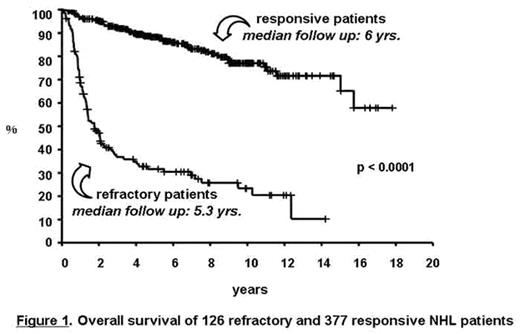Abstract
Introduction: Non-Hodgkin’s lymphoma (NHL) are malignancies usually sensitive to chemotherapy; this results in prolonged survival and often disease eradication in a large proportion of patients. Despite general improvements in treatment options, a variable number of NHL patients still shows refractoriness, i.e. poor or absent response to induction therapy. This study was undertaken to evaluate the actual rate of refractory patients, to identify possible factors predictive of refractory disease and to compare long-term outcome of refractory vs. responsive patients.
Patients and Methods: Data have been collected on 503 NHL patients referred and treated at our Hematology Division between 1990 and 2005. The series included 461 B-cell and 42 T-cell NHL, main histologic subtypes included: 305 high-grade, 183 low-grade and 15 mantle-cell lymphoma. Patient median age was 53 yrs, 55% were male; 359 (73%) patients presented with advanced stage disease. Refractory patients were identified for stable/progressive disease or transient response with disease progression within 6 months, following first-line therapy. Overall, 298 (59%) patients received conventional chemo-radiotherapy, 205 (41%), with either high-risk presentation or unfavorable histology, had high-dose sequential therapy (HDS) with autograft front-line; rituximab was employed in 158 (31%) patients.
Results: Overall, 126 (25%) patients were refractory (39% with no response at all, 61% with short-lasting response soon followed by disease progression). The rate of refractoriness was as high as 40% in the small T-cell NHL subgroup, while the overall incidence was 24% for B-cell NHL. There was no significant difference in the distribution of refractory patients among the histological subtypes of B-NHL, in other words none of the B-cell NHL subtypes was specifically associated with poorer response. Among several parameters evaluated for their potential predictive value, in multivariate logistic regression analysis, two factors only were associated with a higher risk of refractory disease: high serum level of lactate dehydrogenase (LDH) and stages IIB-IV, with an Odds Ratio (OR) of 3.52 and 3.75, respectively; the use of HDS program was associated with reduced risk of refractory disease (OR=0.30). Overall, refractory patients had a definitely short life expectancy, with a median survival of 21 months and a 14-yr survival projection of 10%, which is markedly worse compared to 88%, 76% and 65% survival projections at respectively 5, 10 and 15 yrs., of responsive patients, as shown in Figure 1.
Conclusions. i. patients with refractory disease represent approximately one fourth of NHL undergoing induction therapy; ii. besides advanced stage and high LDH levels, no other clinical and histological factors are specifically associated to refractoriness; iii. further studies are needed to identify markers predictive of refractoriness, in order to design induction therapies adapted for refractory patients, given their dismal outcome with currently available treatment strategies.
Author notes
Disclosure:Research Funding: Some of the Authors have received financial research supports by Roche, Sanofi-Synthelabo and Italfarmaco. Honoraria Information: Some of the authors have been paid as invited speakers at national and international symposia.


This feature is available to Subscribers Only
Sign In or Create an Account Close Modal